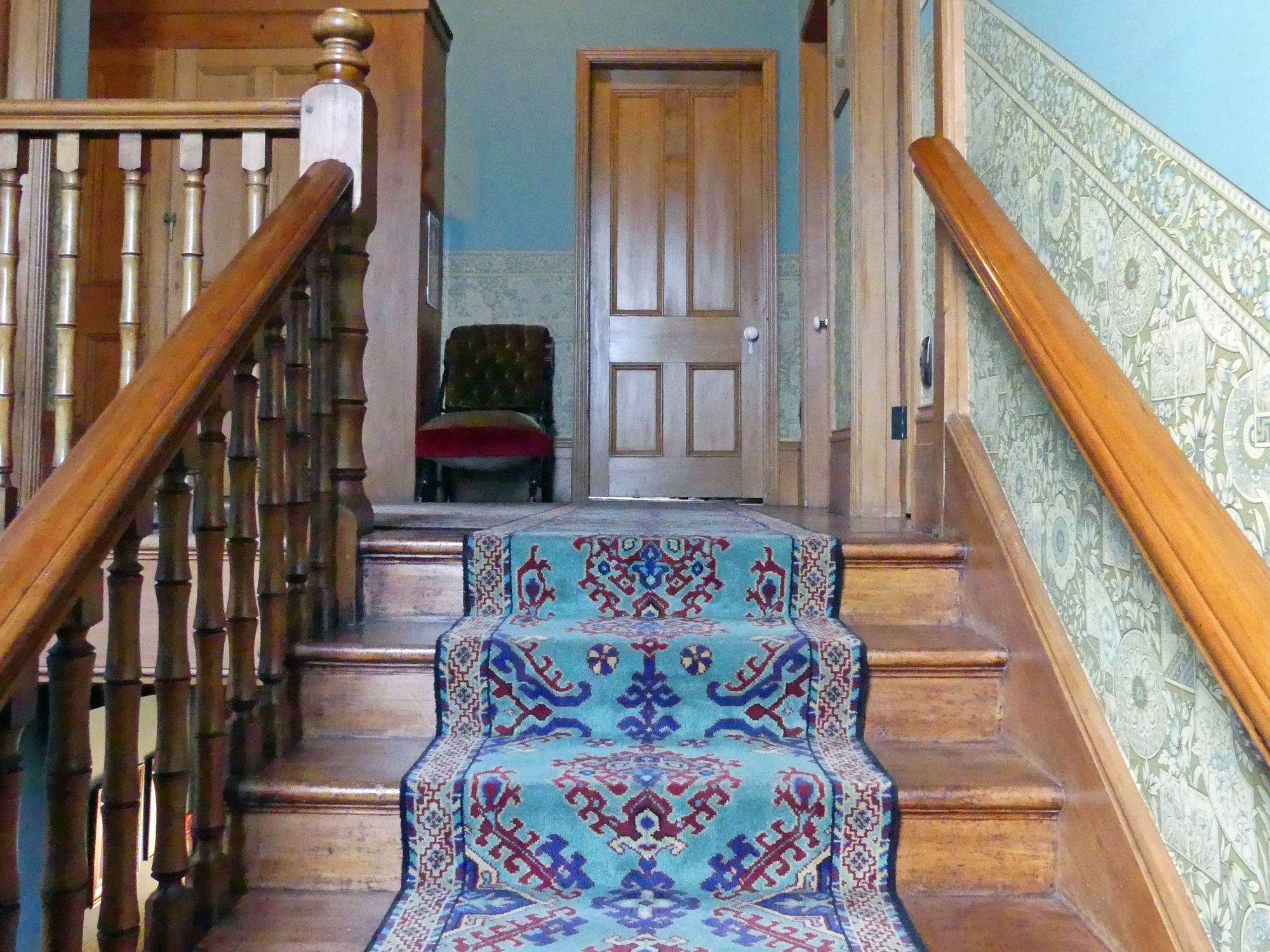A Wellington, sulle scale del Katherine Mansfield Museum
Al museo Katherine Mansfield di Wellington il centro della poetica della scrittrice sono le scale: è l'estetica del passaggio.

Al museo Katherine Mansfield di Wellington il centro della poetica della scrittrice sono le scale: è l'estetica del passaggio.

(English translation below)
Il visitatore del Museo di Katherine Mansfield di Wellington deve scostare due veli. Il primo è la sua apparenza da casa natale della scrittrice. Questo nido della sua infanzia su due piani, con gli spazi canonici della giovane coppia borghese neo-zelandese inizio Novecento (sala da pranzo – regno del capofamiglia, cucina – regno della servitù ben separata, salottino con piccola libreria, e al piano superiore le camere da letto, oltre al piccolo e ordinato giardino) è un’architettura da leggere alla rovescia: il simulacro del mondo dal quale Katherine volle ostinatamente andarsene a diciannove anni.
Qui niente assomiglia a ciò che leggiamo nei racconti, e più che fonte di ispirazione per il suo peregrinare dagli antipodi a Londra, e poi in Svizzera, Italia e Francia, la casa di Wellington fu la molla del rigetto di una società antitetica al suo lesbismo, al suo ostinato infrangere le regole sociali del tempo, e al suo nomadismo che si concluse alla corte di George Gurdjieff – maestro di spiritualità che del viaggio di ricerca e d’iniziazione aveva fatto la sua scuola di vita – che dalla Mansfieled a René Daumal (che insegnò sanscrito a Simone Weil e autore del Monte Analogo) è arrivata a influenzare Peter Brook o Franco Battiato.
Ma è soprattutto l’’altro velo che copre apparenze ingannevoli ad attirare l’attenzione del viaggiatore: sono le scale interne tra i due piani della casa. Ordinarie, in legno, in qualsiasi museo svolgerebbero la loro banale funzione di luogo minore. Invece sono il centro della casa e della poetica di questa scrittrice nomade:
“Non pensi che le scale siano un buon posto per leggere lettere? Io lo faccio. Uno è in qualche modo sospeso. Si è su un terreno neutrale, né nel proprio mondo né in uno strano. Sono un luogo d’incontro quasi perfetto. Oh Cielo! Quanto mi affascinano le scale quando ci penso. Aspettare la gente – sedersi su scale strane – sentire i gradini molto in alto, guardare la luce suonare da sola – sentire – molto al di sotto di una porta, guardare giù in una specie di fioca luminosità, guardare qualcuno che sale. Ma potrei andare avanti all’infinito. Devo metterli in una storia però! Le persone escono da sole sulle scale, escono senza protezione”.
Un’estetica del passaggio, che questa osservatrice dell’essere sospesi e in movimento applica anche, in parti pari, alle stazioni, ai porti, ai grandi luoghi di transito anonimo, di folle e architetture e luci cangianti.
Con intelligenza, il museo stesso invita il visitatore a soffermarsi su questi scalini qualsiasi, cuore dell’opera di Katherine Mansfield, della sua irrequietezza.
Portiamocela a casa, questa irrequietezza che si fa lettura, osservazione, scrittura – ovunque si sia nella nostre transumanze individuali e collettive. Anche noi abbiamo le nostre scali domestiche, quelle della metropolitana dove passiamo ogni giorno, quelle delle nostre città di volti sfuggenti sempre in movimento e ricchi di storie.
Anche noi, di fretta o nella noia delle attese, transitiamo per stazioni e porti. Non sono luoghi ordinari, ma il punto di osservazione privilegiato del nostro muoversi, dei nostri moti – in tutti i sensi – avvolti dal ritmo dell’umanità, dalla geografia e, dall’architettura, dall’arredamento del passaggio. Che è il punto nel quale nessuno si mette in mostra, dove emerge maggiore verità: la rivelazione della bellezza, della profondità dell’ordinario, nelle scale di casa o della città, che fin qui ci è sfuggita.
ENGLISH VERSION
At the Katherine Mansfield museum in Wellington, the center of the writer’s poetics are the stairs: it is the aesthetics of the passage.
Two veils the visitor to the Katherine Mansfield Museum of Wellington must part. The first is its appearance as the birthplace of the writer. This nest of her childhood on two floors, with the canonical spaces of the young New Zealand bourgeois couple at the beginning of the twentieth century – dining room-kingdom of the head of the family, (well-separated kitchen -kingdom of the servants, sitting room with small bookcase, and, upstairs, bedroom, in addition to the small and tidy garden) it is an architecture to be understood upside down.
It is the simulacrum of the world from which Katherine stubbornly wanted to leave when she was nineteen. Nothing here resembles what we read in her stories. Rather than a source of inspiration for her wanderings (from the antipodes to London, and then to Switzerland, Italy, and France), the home of Wellington was the first step in her rejecting of a society antithetical to her lesbianism, her obstinate breaking of the social rules of the time, and her nomadism which ended at the court of George Gurdjieff. Master of spirituality, Gurdjieff had made the journey of research and initiation his life school – an inspiration for many, from Mansfield or René Daumal (who taught Sanskrit to Simone Weil and author of “Mount Analogue”) to, nowadays, Peter Brook or Franco Battiato.
For a traveler, is far more important the second veil that covers deceptive appearances: the internal stairs between the two floors of the house. Ordinary, in wood, in any museum they would only perform their banal function. Instead, they are the central place of the house and of the poetics of this nomadic writer:
“Don’t you think the stairs are a good place for reading letters? I do. One is somehow suspended. One is on neutral ground – neither in one’s own world nor in a strange one. They are an almost perfect meeting place. Oh Heavens! How stairs do fascinate me when I think of it. Waiting for people – sitting on strange stairs – hearing steps far above, watching the light playing by itself – hearing – far below a door, looking down into a kind of dim brightness, watching someone come up. But I could go on forever. Must put them in a story though! People come out of themselves on stairs – they issue forth, unprotected.”
This is an aesthetic of passage, of suspension, that Katherine Mansfield observes equally at stations, ports, large places of anonymous transit, of crowds and architectures, and changing lights.
Cleverly, the Museum itself invites the visitor to linger on these ordinary steps, being an essential element of Katherine’s work, of her restlessness.
Let’s take home this restlessness that becomes reading, observation, writing – wherever we are in our individual and collective transhumance. We too have our domestic stairs, those of the subway where we pass every day, and those of our cities of elusive faces always on the move and full of stories. They are not ordinary places, but the privileged observation point of our movement, of our motions – in every sense. It is the merit of great artists to reveal to us the beauty, the depth of the ordinary that has so far escaped us.
